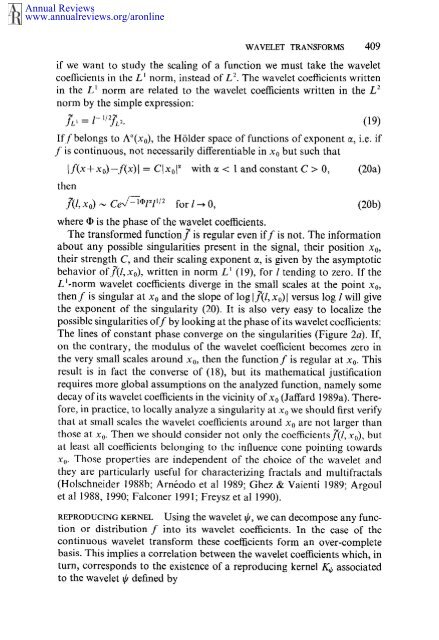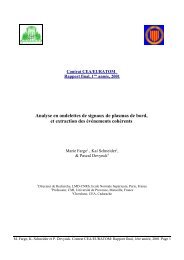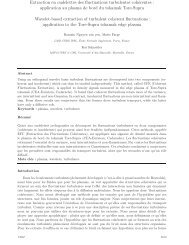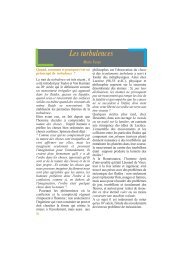wavelet transforms and their applications to turbulence - Wavelets ...
wavelet transforms and their applications to turbulence - Wavelets ...
wavelet transforms and their applications to turbulence - Wavelets ...
You also want an ePaper? Increase the reach of your titles
YUMPU automatically turns print PDFs into web optimized ePapers that Google loves.
Annual Reviewswww.annualreviews.org/aronlineWAVELET TRANSFORMS 409if we want <strong>to</strong> study the scaling of a function we must take the <strong>wavelet</strong>coefficients in the L ~ norm, instead of L 2. The <strong>wavelet</strong> coefficients writtenin the L t norm 2 are related <strong>to</strong> the <strong>wavelet</strong> coeff~cients written in the Lnorm by the simple expression:fL’ = l-1/2yL2. (19)Iffbelongs <strong>to</strong> A~(x0), the H61der space of functions of exponent ~, i.e.f is continuous, not necessarily differentiable in x0 but such thatthenIf(x+xo)-f(x)[ = Clxol ~ with g < 1 <strong>and</strong> constant C > 0, (20a)3~(/, x0) Ce’f~*l~l 1/~ for l ~ 0, (20b)where @ is the phase of the <strong>wavelet</strong> coefficients.The transformed function f is regular even iff is not. The informationabout any possible singularities present in the signal, <strong>their</strong> position x0,<strong>their</strong> strength C, <strong>and</strong> <strong>their</strong> scaling exponent ~, is given by the asymp<strong>to</strong>ticbehavior off(l, xo), written in norm L ~ (19), for l tending <strong>to</strong> zero. If theL~-norm <strong>wavelet</strong> coefficients diverge in the small scales at the point Xo,then f is singular at x0 <strong>and</strong> the slope of log If(l, x0) l versus log l will givethe exponent of the singularity (20). It is also very easy <strong>to</strong> localize thepossible singularities off by looking at the phase of its <strong>wavelet</strong> coefficients:The lines of constant phase converge on the singularities (Figure 2a). If,on the contrary, the modulus of the <strong>wavelet</strong> coefficient becomes zero inthe very small scales around xo, then the functionf is regular at x0. Thisresult is in fact the converse of (18), but its mathematical justificationrequires more global assumptions on the analyzed function, namely somedecay of its <strong>wavelet</strong> coefficients in the vicinity of x0 (Jaffard 1989a). Therefore,in practice, <strong>to</strong> locally analyze a singularity at x0 we should first verifythat at small scales the <strong>wavelet</strong> coefficients around x0 are not larger thanthose at x0. Then we should consider not only the coefficientsf(l, x0), butat least all coefficients belonging <strong>to</strong> the influence cone pointing <strong>to</strong>wardsx0. Those properties are independent of the choice of the <strong>wavelet</strong> <strong>and</strong>they are particularly useful for characterizing fractals <strong>and</strong> multifractals(Holschneider 1988b; Arn+odo et al 1989; Ghez & Vaienti 1989; Argoulet al 1988, 1990; Falconer 1991; Freysz et al 1990).REPRODUCING KERNEL Using the <strong>wavelet</strong> ~k, we can decompose any functionor distribution f in<strong>to</strong> its <strong>wavelet</strong> coefficients. In the case of thecontinuous <strong>wavelet</strong> transform these coefficients form an over-completebasis. This implies a correlation between the <strong>wavelet</strong> coefficients which, inturn, corresponds <strong>to</strong> the existence of a reproducing kernel K6 associated<strong>to</strong> the <strong>wavelet</strong> ~ defined by





